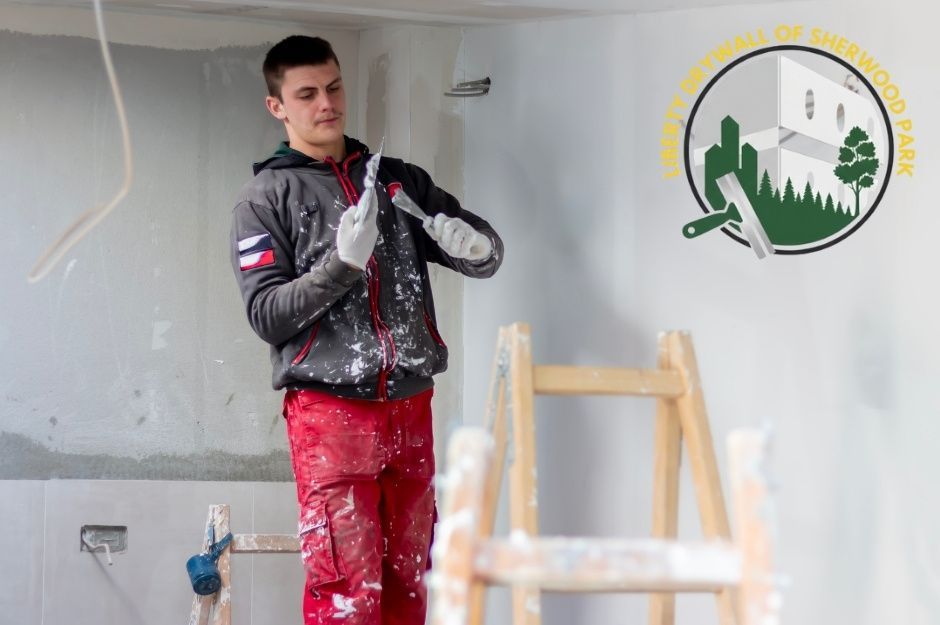Gibbons Drywall Repair
Experienced Wallboard Repair Company in Gibbons, Alberta

Professional drywall contractors at Liberty Drywall Sherwood Park in Gibbons, Alberta offer comprehensive repair and installation services to restore your walls and ceilings to pristine condition. These local contractors provide essential services including crack repair, hole patching, dent fixing, popcorn ceiling removal, and water damage restoration, along with full installation and soundproofing solutions.
Located just 37 km northeast of Edmonton along Highway 28A, Gibbons serves a growing residential community where temperature fluctuations between Alberta's harsh winters and warm summers can cause significant drywall stress. From fixing unsightly cracks and holes to addressing water damage and nail pops, these skilled technicians have the expertise to handle any drywall challenge.
Your home's walls deserve expert attention, and Gibbons-area contractors deliver reliable drywall finishing services through precise mudding and taping techniques. They use specialized compounds and professional-grade materials to ensure smooth, seamless results that last. Whether you need a small repair or complete drywall installation, licensed professionals can transform your space while maintaining cleanliness and efficiency throughout the project.

Liberty Drywall of Sherwood Park (CP)

Comprehensive Drywall Repair Services in Gibbons, Alberta
Professional drywall repair services in Gibbons restore walls and ceilings to pristine condition using specialized techniques and high-quality materials. The town's proximity to the Sturgeon River means homes may experience higher humidity levels, making proper moisture management crucial for long-lasting drywall repairs.
Crack Repairs for Walls and Ceilings
Wall cracks can appear from house settling, temperature changes, or structural movement. In Gibbons, the freeze-thaw cycles typical of central Alberta's climate can cause foundations to shift, leading to stress cracks in drywall throughout the year. Professional repair teams use flexible compounds to prevent cracks from returning.
Your repair technician will assess the crack type and determine the best repair method. Small hairline cracks need different treatment than deeper structural cracks.
The repair process includes cleaning the crack area, applying reinforcement tape, and layering joint compound for a seamless finish. Multiple thin coats ensure better adhesion and durability.
Hole and Dent Restoration
From small nail holes to large drywall damage, proper restoration requires specific techniques for each size of repair.
Small dents and punctures are filled with lightweight spackling compound. Medium-sized holes need mesh patches and joint compound application.
Large holes require new drywall pieces cut to size. Professionals carefully match existing wall texture and blend repairs invisibly with surrounding surfaces.
Fixing Nail and Screw Pops
Nail and screw pops create unsightly bumps in your walls. These common issues often appear in newer homes as building materials settle. With Gibbons experiencing continued residential development as part of the Edmonton metropolitan region, many homes are less than 10 years old and particularly susceptible to nail pops during the settling period.
The repair process involves removing loose fasteners and replacing them with drywall screws in new locations. Fresh joint compound covers the repairs.
Multiple thin coats of compound ensure a smooth finish that won't show through paint.
Specialized Popcorn Ceiling and Sagging Repairs
Popcorn ceiling repairs require careful matching of texture patterns. Repair teams use specialized tools to blend new texture with existing surfaces.
Water damage often causes ceiling sag. Given Gibbons' location on the southern banks of the Sturgeon River, properties near the waterway may experience occasional flooding or moisture infiltration that can compromise ceiling integrity. Professionals assess the extent of damage before starting repairs.
For sagging ceilings, technicians secure loose drywall with new fasteners and install support where needed. They then refinish the area to match surrounding textures.
The repair team tests affected areas for moisture problems and addresses any underlying issues before completing cosmetic repairs.
Mitigating Seams and Water Damage
Professional drywall repair specialists employ specific techniques to fix damaged seams and address moisture-related issues, preserving both structural integrity and visual appeal. Gibbons contractors are well-versed in handling water damage from both the Sturgeon River's proximity and Alberta's heavy spring snowmelt, which can affect basements and lower-level walls.
Addressing Exposed or Damaged Seams
Seam repair requires careful attention to detail and proper materials. Start by removing any loose tape or compound from the affected area.
Apply new drywall tape along the seam, pressing firmly to ensure proper adhesion. Use paper tape rather than mesh for better results on flat seams.
Layer joint compound over the tape in three thin coats, feathering each layer progressively wider to blend with surrounding wall surfaces. Sand between coats for optimal smoothness.
Common seam issues to watch for:
- Visible tape lines
- Bubbling or peeling
- Cracking along joint lines
- Uneven surface texture
Water Damage Assessment and Restoration
Your first step is identifying the water source and fixing it before beginning repairs. Look for discoloration, softened drywall, or mold growth as indicators of damage. In Gibbons' humid continental climate (Köppen classification Dfb), basement moisture problems are particularly common during spring and early summer months.
Remove all wet material extending 12 inches beyond visible damage. Allow the area to dry completely using fans and dehumidifiers.
Restoration steps:
- Cut out damaged sections in straight lines
- Install new moisture-resistant drywall
- Tape and mud joints with water-resistant compounds
- Prime and paint to match existing finish
Inspect surrounding insulation and framing for additional damage that might need addressing.
Professional Drywall Installation Solutions
Professional drywall installation requires precise measurements, proper anchoring techniques, and expert finishing to create smooth, durable walls and ceilings. Expert contractors use specialized tools and proven methods to ensure your new drywall meets building codes and quality standards. Gibbons contractors follow Alberta Building Code requirements and are familiar with Sturgeon County's specific permitting processes for renovation and construction projects.
New Drywall Hanging for Residential and Commercial Spaces
Your new drywall installation starts with selecting the right type and thickness of boards for your specific application. Most residential walls use 1/2-inch drywall, while ceilings often require 5/8-inch panels for added strength.
Professional installers measure and cut boards to fit precisely around electrical boxes, windows, and doors. They secure panels using appropriate screws and anchors spaced according to local building codes. Many Gibbons homes built in the 1970s-1990s are undergoing renovations, requiring contractors to match new drywall installations with older construction standards while upgrading to modern efficiency requirements.
Teams use specialized lifts and supports to ensure accurate ceiling installations. This equipment prevents sagging and maintains level surfaces throughout the installation process.
Soundproof Drywall Installation
Soundproof drywall installation incorporates specialized materials and techniques to reduce noise transmission between rooms. These panels contain sound-dampening materials within their core structure. With Gibbons' proximity to Highway 28A and the CN Rail line running through the region, soundproofing has become increasingly popular for homes near these transportation corridors.
Multiple layer installations with acoustic sealants create superior sound barriers. Contractors offset the seams between layers to maximize sound reduction capabilities.
Professional installers add insulation between wall cavities before hanging soundproof drywall. They seal all gaps around electrical outlets and other penetrations to maintain sound blocking effectiveness.
Your soundproofing results depend on proper installation techniques and attention to detail at every joint and connection point.
Expert Drywall Finishing: Mudding and Taping
Professional mudding and taping transforms bare drywall joints into seamless walls. Proper technique and high-quality materials create surfaces ready for paint or texture. Gibbons contractors must account for low humidity during Alberta's winter months, which can cause joint compound to dry too quickly and crack, requiring careful moisture control during application.
Precision Mudding Techniques
Your drywall joints require three layers of compound for optimal results. The first coat fills gaps and embeds paper tape, while the second spreads wider to level the surface.
Use a 6-inch knife for your first coat, followed by a 10-inch knife for the second layer. The final coat requires a 12-inch knife to feather edges smoothly into the surrounding wall.
Essential mudding steps:
- Mix compound to creamy consistency
- Apply thin, even layers
- Allow 24 hours drying between coats
- Sand lightly between applications
Seamless Taping for Smooth Surfaces
Start by cutting tape to length before applying compound. Press tape firmly into fresh mud along joints, removing air bubbles with your drywall knife.
Corner taping tips:
- Use corner bead for outside corners
- Fold tape for inside corners
- Overlap intersecting joints
- Pre-crease tape for tight fits
Apply moderate pressure when embedding tape to avoid wrinkles or blisters. Your tape should lie completely flat with no edges lifting.
Keep your tools clean between applications for the smoothest results. Wipe knives frequently to prevent dried compounds from creating lines or scratches in your work. Local Gibbons contractors typically complete projects within 3-5 days for standard room repairs, allowing proper drying time between coats even during the town's coldest winter months when indoor heating can affect compound curing rates.

